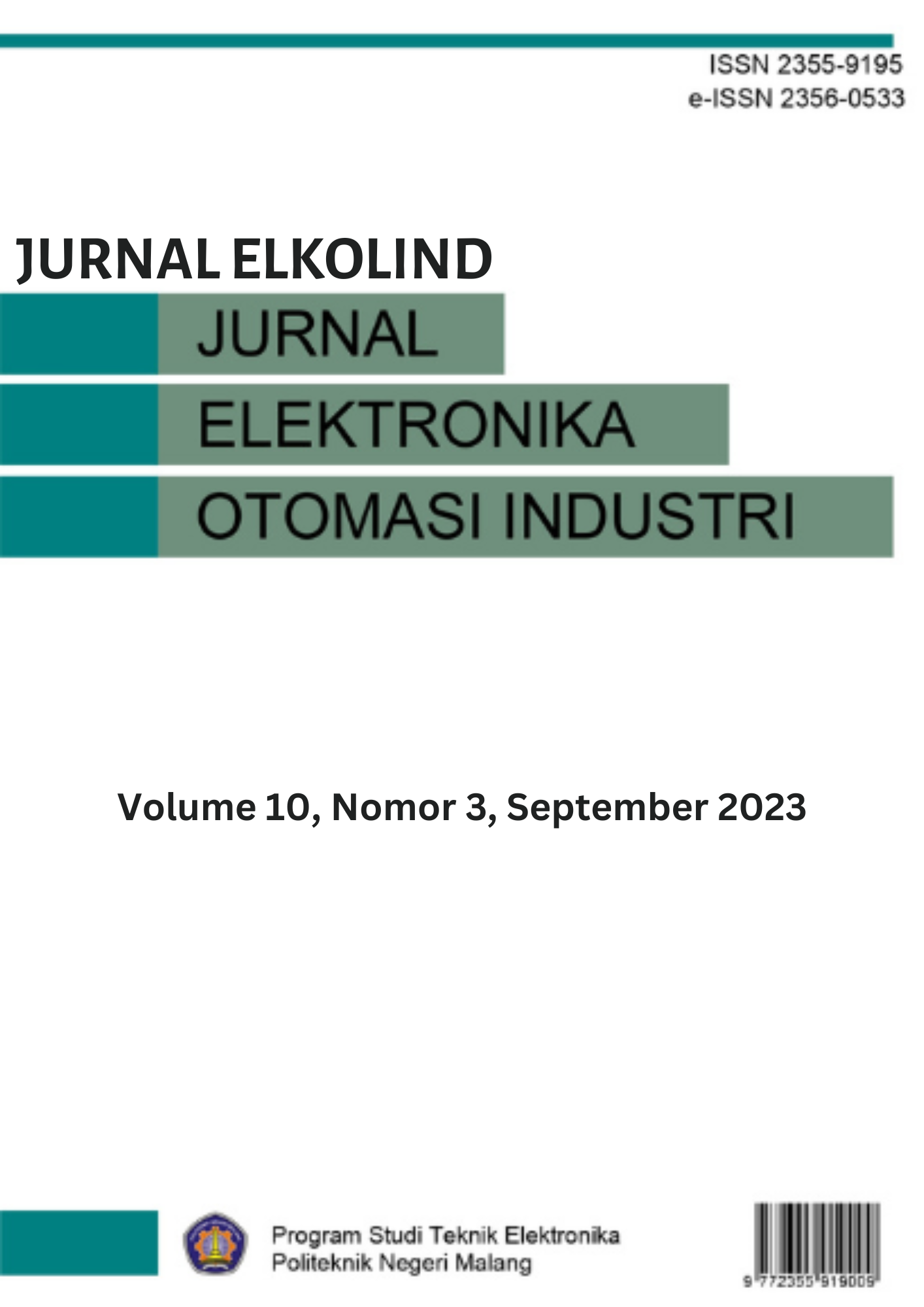Main Article Content
Abstract
A system using Internet of Things (IoT) technology has been developed to assist farmers in efficiently feeding their pet ducks. This system based on the Internet Of Things (IoT) method, involves various components such as loadcell and ultrasonic sensors, servo motors, a real-time clock, LCD display, power supply, and the NodeMCU ESP8266 microcontroller. The feeding process starts by filling the feed into a container hopper. The ultrasonic sensor detects the feed level and sends this information to the Blynk application. The application then opens servo motor 1 to drop the feed into a small container with a loadcell. The loadcell sensor measures the weight of the feed, and then servo motor 1 closes and servo motor 2 opens until the feed runs out, at which point servo motor 2 closes. The system continuously repeats this process and sends notifications to the Blynk application when the hopper is empty. Overall, this system helps to streamline the feeding process for pet ducks and improve efficiency for farmers.
Article Details
Copyright (c) 2023 Zahra Atharid Yasmin Yasmin, Made Rahmawaty Made, Nur Khamdi Khamdi, Edilla Edilla

This work is licensed under a Creative Commons Attribution 4.0 International License.
References
- J. A. Lase and D. D. Lestari, “Potensi Ternak Entok (Cairina Moschata) Sebagai Sumber Daging Alternatif Dalam Mendukung Ketahanan Pangan Nasional,” Pros. Semin. Nas. Fak. Pertan. UNS, vol. 4, no. 1, pp. 479–490, 2020, [Online]. Available: https://jurnal.fp.uns.ac.id/index.php/semnas/article/view/1697.
- R. William, “Memelihara hewan peliharaan,” pp. 1–5.
- R. Devitasari dkk, “RANCANG BANGUN ALAT PEMBERI PAKAN KUCING OTOMATIS MENGGUNAKAN MIKROKONTROLER NODEMCU BERBASIS INTERNET OF THINGS (IOT),” vol. 14, no. 2, pp. 152–164, 2020.
- K. Wiajaya dkk, “MONITORING SISA PAKAN KUCING BERBASIS INTERNET OF THINGS ( IOT ),” 2019.
- M. H. Baehaki and S. I. Lestariningati, “Jurusan Teknik Komputer Unikom , Bandung Mochamad Hilman Baehaki , Susmini Indriani Lestariningati Pengujian Status Tank pada saat kondisi Full ( Penuh ),” vol. 6, no. 1, pp. 13–16, 2017.
- C. Y. Aritonang, “Rancang Bangun Alat Pemberi Makan Hewan Peliharaan Otomatis,” IJNS - Indones. J. Netw. Secur., vol. 10, no. 3, 2021, doi: 10.55181/ijns.v10i3.1742.
- H. Mahanani, “PEMBANGUNAN ALAT PEMBERI MAKAN HEWAN PELIHARAAN BERBASIS INTERNET OF THINGS PROGRAM STUDI INFORMATIKA,” 2020.
- Wahyudi, Abdur Rahman, and Muhammad Nawawi, “Perbandingan Nilai Ukur Sensor Load Cell pada Alat Penyortir Buah Otomatis terhadap Timbangan Manual,” J. ELKOMIKA, vol. 5, no. 2, pp. 207–220, 2017.
- S. Syamsiah, “Perancangan Flowchart dan Pseudocode Pembelajaran Mengenal Angka dengan Animasi untuk Anak PAUD Rambutan,” STRING (Satuan Tulisan Ris. dan Inov. Teknol., vol. 4, no. 1, p. 86, 2019, doi: 10.30998/string.v4i1.3623.
- R. S. Zukro Aini, A. Arifin, and A. F. Babgei, “Perancangan Mekanik Pulmonary Rehabilitation Robot sebagai Pendukung Mekanisme Rehabilitasi Asma Breathing Retraining,” J. Tek. ITS, vol. 9, no. 1, pp. 47–52, 2020, doi: 10.12962/j23373539.v9i1.48237.
- J. A. Stankovic, “Research directions for the internet of things,” IEEE Internet Things J., vol. 1, no. 1, pp. 3–9, 2014, doi: 10.1109/JIOT.2014.2312291.
- W. A. Prayitno, A. Muttaqin, and D. Syauqy, “Sistem Monitoring Suhu, Kelembaban, dan Pengendali Penyiraman Tanaman Hidroponik menggunakan Blynk Android,” J. Pengemb. Teknol. Inf. dan Ilmu Komput., vol. 1, no. 4, pp. 292–297, 2017.
References
J. A. Lase and D. D. Lestari, “Potensi Ternak Entok (Cairina Moschata) Sebagai Sumber Daging Alternatif Dalam Mendukung Ketahanan Pangan Nasional,” Pros. Semin. Nas. Fak. Pertan. UNS, vol. 4, no. 1, pp. 479–490, 2020, [Online]. Available: https://jurnal.fp.uns.ac.id/index.php/semnas/article/view/1697.
R. William, “Memelihara hewan peliharaan,” pp. 1–5.
R. Devitasari dkk, “RANCANG BANGUN ALAT PEMBERI PAKAN KUCING OTOMATIS MENGGUNAKAN MIKROKONTROLER NODEMCU BERBASIS INTERNET OF THINGS (IOT),” vol. 14, no. 2, pp. 152–164, 2020.
K. Wiajaya dkk, “MONITORING SISA PAKAN KUCING BERBASIS INTERNET OF THINGS ( IOT ),” 2019.
M. H. Baehaki and S. I. Lestariningati, “Jurusan Teknik Komputer Unikom , Bandung Mochamad Hilman Baehaki , Susmini Indriani Lestariningati Pengujian Status Tank pada saat kondisi Full ( Penuh ),” vol. 6, no. 1, pp. 13–16, 2017.
C. Y. Aritonang, “Rancang Bangun Alat Pemberi Makan Hewan Peliharaan Otomatis,” IJNS - Indones. J. Netw. Secur., vol. 10, no. 3, 2021, doi: 10.55181/ijns.v10i3.1742.
H. Mahanani, “PEMBANGUNAN ALAT PEMBERI MAKAN HEWAN PELIHARAAN BERBASIS INTERNET OF THINGS PROGRAM STUDI INFORMATIKA,” 2020.
Wahyudi, Abdur Rahman, and Muhammad Nawawi, “Perbandingan Nilai Ukur Sensor Load Cell pada Alat Penyortir Buah Otomatis terhadap Timbangan Manual,” J. ELKOMIKA, vol. 5, no. 2, pp. 207–220, 2017.
S. Syamsiah, “Perancangan Flowchart dan Pseudocode Pembelajaran Mengenal Angka dengan Animasi untuk Anak PAUD Rambutan,” STRING (Satuan Tulisan Ris. dan Inov. Teknol., vol. 4, no. 1, p. 86, 2019, doi: 10.30998/string.v4i1.3623.
R. S. Zukro Aini, A. Arifin, and A. F. Babgei, “Perancangan Mekanik Pulmonary Rehabilitation Robot sebagai Pendukung Mekanisme Rehabilitasi Asma Breathing Retraining,” J. Tek. ITS, vol. 9, no. 1, pp. 47–52, 2020, doi: 10.12962/j23373539.v9i1.48237.
J. A. Stankovic, “Research directions for the internet of things,” IEEE Internet Things J., vol. 1, no. 1, pp. 3–9, 2014, doi: 10.1109/JIOT.2014.2312291.
W. A. Prayitno, A. Muttaqin, and D. Syauqy, “Sistem Monitoring Suhu, Kelembaban, dan Pengendali Penyiraman Tanaman Hidroponik menggunakan Blynk Android,” J. Pengemb. Teknol. Inf. dan Ilmu Komput., vol. 1, no. 4, pp. 292–297, 2017.
